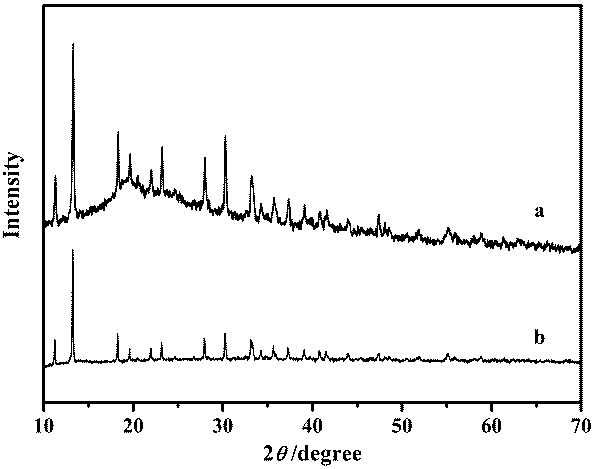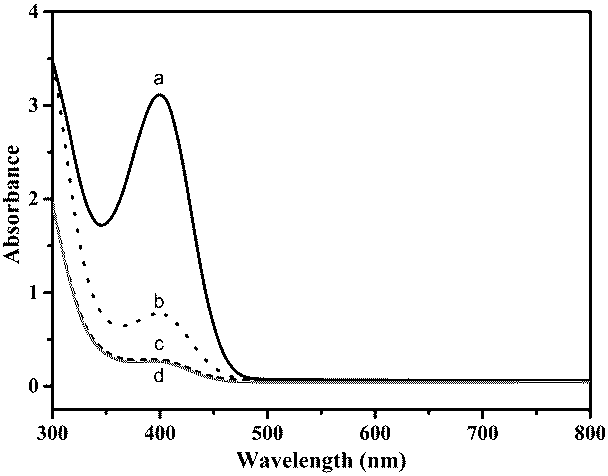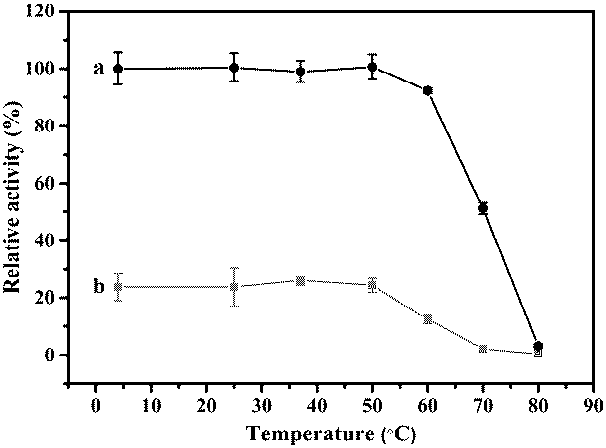Method for increasing activity and stability of microbial surface-displayed organophosphorus hydrolase
A surface display, microbial technology, applied in the fields of enzyme engineering and material science, can solve problems such as activity and stability that are not involved, achieve the effect of improving activity and stability, improving the activity or stability of enzymes, and simple preparation method
- Summary
- Abstract
- Description
- Claims
- Application Information
AI Technical Summary
Problems solved by technology
Method used
Image
Examples
Embodiment 1
[0019] Preparation of microorganisms displaying organophosphate hydrolases on their surface:
[0020] Preparation Method References: X. Tang, B. Liang, T. Yi, G. Manco, I. Palchetti, A. Liu, Cell Surface Display of Organophosphorus Hydrolase for SensitiveSpectrophotometric Detection of p-Nitrophenol Substituted Organophosphates. Enzyme and Microbial Technology, 2014, 55, 107−112. Specifically, the genes of Ankyrin and OPH were inserted into the plasmid and transformed into Escherichia coli competent cells ( E. coli BL21), the engineered bacteria were shaken and cultivated in LB medium containing kanamycin resistance at 37 °C; when the absorbance of the culture solution at 600 nm (referred to as OD 600 nm ) was about 0.6, adding isopropyl-β-d-thiogalactoside to induce the expression of ankyrin and OPH and displayed on the cell surface; after 10 hours of shaking culture at 37 °C, centrifuge (6000 rpm, 5 minutes) to collect bacteria.
Embodiment 2
[0022] Preparation of microorganism-cobalt phosphate octahydrate hybrid material displaying organophosphate hydrolase on the surface:
[0023] (1) E. coli exhibiting organophosphate hydrolase on the surface (final OD 600 nm = 6) Add to phosphate buffer solution (pH 7.4) and mix well; (2) Add cobalt chloride aqueous solution (0.5 mM) to the above mixed solution and mix well, after standing at room temperature for one day, the generated cobalt phosphate salt is uniform Distributed on the surface of microorganisms, thereby forming a microorganism-cobalt phosphate octahydrate hybrid material exhibiting organophosphate hydrolase on the surface; (3) Centrifuge the above reaction solution, remove the supernatant containing unreacted components, collect the precipitate, and store at 4°C Reserved for later use, the quantities of materials are listed in the corresponding E. coli OD 600 nm remember.
[0024]Another control experiment: with no display E. coli Replacement surfaces dis...
Embodiment 3
[0026] Morphology and elemental analysis of a microbial-cobalt phosphate octahydrate hybrid material displaying organophosphate hydrolases on its surface:
[0027] After the suspension of the above hybrid material was dried at room temperature, its morphology was analyzed by scanning electron microscope and transmission electron microscope. figure 1 A is a scanning electron microscope photo of the hybrid material. It can be seen from the figure that the prepared hybrid material has a spindle-shaped structure with a length of about 1 µm and a diameter of about 450 nm, which basically maintains the microbial cells before biomineralization. size. figure 1 B and C are the transmission electron micrographs of the hybrid material, which further confirm the spindle-shaped structure of the hybrid material, and it can be seen from the figure that the surface of the hybrid material has a layered structure.
[0028] The above hybrid materials were analyzed by X-ray energy spectroscopy...
PUM
| Property | Measurement | Unit |
|---|---|---|
| Diameter | aaaaa | aaaaa |
Abstract
Description
Claims
Application Information
 Login to View More
Login to View More - R&D
- Intellectual Property
- Life Sciences
- Materials
- Tech Scout
- Unparalleled Data Quality
- Higher Quality Content
- 60% Fewer Hallucinations
Browse by: Latest US Patents, China's latest patents, Technical Efficacy Thesaurus, Application Domain, Technology Topic, Popular Technical Reports.
© 2025 PatSnap. All rights reserved.Legal|Privacy policy|Modern Slavery Act Transparency Statement|Sitemap|About US| Contact US: help@patsnap.com



